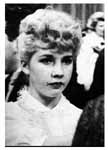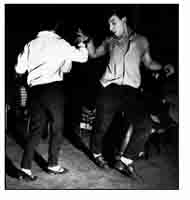'50s JITTERBUG
aka FAST DANCING
aka LINDY aka ROCK 'n ROLL - wrap-up
kurt lichtmann


Bandstand's "dance contests" were, in reality, only marginally about dancing:
they were basically personality polls. Teens modeled not only their dancing,
but their clothing, hairstyles, make-up, everything, after their favorite Bandstand
peer models. The fan mail was unimaginable: 45,000 letters a week. The popularity
of favorite Bandstanders rivalled that of Elvis Presley and Ricky Nelson! Since
the TV cameras spent extra time on these Bandstanders, their dance styles were
particularly influential.
Justine Carelli (left) and Bunny Gibson(right) were very popular.
Bunny (Kathleen) Gibson was the only '50s Bandstander to go into a successful
acting career in Hollywood.
Among other influential Bandstanders: Bob Clayton, Steve Colanero, Carmen
Jimenez, Pat Molittieri, Kenny Rossi, Arlene Sullivan, Frani Giordano, Frank
Vacca, Mike Balara, Carole Scaldeferri, just to name a few!
 The Web: In retrospect, for Dick Clark in the '50s, dancing as
an important social phenomenon was utterly secondary to his interests. But he
was certainly promoting it, right? So, you ask, why did he encourage regulars
to showcase new dances? Although the personable Clark obviously enjoyed hosting
the show, American Bandstand was, in one sense, a vast promotional stage for
his massively complex record industry investments. Among his many talents, Dick
Clark is an entrepreneurial genius. He owned and partially owned record labels,
song copyrights, and managed artists. A new dance meant a new dance SONG to
commission, a new dance RECORD to plug (through one of his many holdings), and
more MONEY in the bank. Conflict of interests? Nah, tightly woven lucrative
web of interests. (At the time, frequently featured Bandstand guitarist Duane
Eddy, in the photo, didn't even know that Clark partly owned his career!)
Let's not put him down for this: there is a lot to be learned on the business
side from this whole scenario.
The Web: In retrospect, for Dick Clark in the '50s, dancing as
an important social phenomenon was utterly secondary to his interests. But he
was certainly promoting it, right? So, you ask, why did he encourage regulars
to showcase new dances? Although the personable Clark obviously enjoyed hosting
the show, American Bandstand was, in one sense, a vast promotional stage for
his massively complex record industry investments. Among his many talents, Dick
Clark is an entrepreneurial genius. He owned and partially owned record labels,
song copyrights, and managed artists. A new dance meant a new dance SONG to
commission, a new dance RECORD to plug (through one of his many holdings), and
more MONEY in the bank. Conflict of interests? Nah, tightly woven lucrative
web of interests. (At the time, frequently featured Bandstand guitarist Duane
Eddy, in the photo, didn't even know that Clark partly owned his career!)
Let's not put him down for this: there is a lot to be learned on the business
side from this whole scenario.
 It came, it went: Had Dick Clark valued the significance of partner
dancing, he might have encouraged his regulars to INCORPORATE (as happened in
Lindy Hop) the many new moves INTO their Jitterbug repertoire. 'We are talking
about a very influential individual: Dick Clark was influencing an entire generation.
He could have done ANYTHING he wanted, if he kept up the ratings. But, the money
was not in this approach. Or maybe a new DANCE keeps viewer interest more than
a new MOVE in a pre-existing dance. Anyway, American Bandstand ultimately brought
America's teens to dance in complete breakaway formation, with increasingly
simplistic and tedious specialty dances (starting with the Twist, then the Pony,
the Mashed Potatoes, the Jerk, the Monkey, etc.). Fortunately this style of
dancing apart did not last on the show, but it did last in the clubs and bars
or America into the modern era.
It came, it went: Had Dick Clark valued the significance of partner
dancing, he might have encouraged his regulars to INCORPORATE (as happened in
Lindy Hop) the many new moves INTO their Jitterbug repertoire. 'We are talking
about a very influential individual: Dick Clark was influencing an entire generation.
He could have done ANYTHING he wanted, if he kept up the ratings. But, the money
was not in this approach. Or maybe a new DANCE keeps viewer interest more than
a new MOVE in a pre-existing dance. Anyway, American Bandstand ultimately brought
America's teens to dance in complete breakaway formation, with increasingly
simplistic and tedious specialty dances (starting with the Twist, then the Pony,
the Mashed Potatoes, the Jerk, the Monkey, etc.). Fortunately this style of
dancing apart did not last on the show, but it did last in the clubs and bars
or America into the modern era.
THE 1970s: with disco and the hustle, partner dancing all came back. And,
it came back with much greater sophistication, and a much more dance friendly
TV studio than in the 1950s. But a whole generation (the 1960s teens) got left
out. A new generation of America's teens were again earning partner dance on
American Bandstand. So kudos after all to Dick Clark, a master at going with
the flow.
- - - - - - - - - - - - - - -
SOURCES: Conversations with Bandstand regular Bunny Gibson, conversations
and dancing with Bandstand regular Steve Colanero, NYC dance pros Meredith
Stead and John Knapp, conversations with Arthur Murray Instructor
and cinema performer Mickey Potenza, and the numerous boomers we've talked
and danced with, who learned the style from American Bandstand.
AMERICAN BANDSTAND, John A. Jackson (Oxford U., NY 1997)
DICK CLARK'S AMERICAN BANDSTAND, Dick Clark Productions, Inc. (Harper
Collins, NY 1997)
DICK CLARK'S BEST OF BANDSTAND (Vestron Music Video, 1986)
 The Web: In retrospect, for Dick Clark in the '50s, dancing as
an important social phenomenon was utterly secondary to his interests. But he
was certainly promoting it, right? So, you ask, why did he encourage regulars
to showcase new dances? Although the personable Clark obviously enjoyed hosting
the show, American Bandstand was, in one sense, a vast promotional stage for
his massively complex record industry investments. Among his many talents, Dick
Clark is an entrepreneurial genius. He owned and partially owned record labels,
song copyrights, and managed artists. A new dance meant a new dance SONG to
commission, a new dance RECORD to plug (through one of his many holdings), and
more MONEY in the bank. Conflict of interests? Nah, tightly woven lucrative
web of interests. (At the time, frequently featured Bandstand guitarist Duane
Eddy, in the photo, didn't even know that Clark partly owned his career!)
Let's not put him down for this: there is a lot to be learned on the business
side from this whole scenario.
The Web: In retrospect, for Dick Clark in the '50s, dancing as
an important social phenomenon was utterly secondary to his interests. But he
was certainly promoting it, right? So, you ask, why did he encourage regulars
to showcase new dances? Although the personable Clark obviously enjoyed hosting
the show, American Bandstand was, in one sense, a vast promotional stage for
his massively complex record industry investments. Among his many talents, Dick
Clark is an entrepreneurial genius. He owned and partially owned record labels,
song copyrights, and managed artists. A new dance meant a new dance SONG to
commission, a new dance RECORD to plug (through one of his many holdings), and
more MONEY in the bank. Conflict of interests? Nah, tightly woven lucrative
web of interests. (At the time, frequently featured Bandstand guitarist Duane
Eddy, in the photo, didn't even know that Clark partly owned his career!)
Let's not put him down for this: there is a lot to be learned on the business
side from this whole scenario.


 It came, it went: Had Dick Clark valued the significance of partner
dancing, he might have encouraged his regulars to INCORPORATE (as happened in
Lindy Hop) the many new moves INTO their Jitterbug repertoire. 'We are talking
about a very influential individual: Dick Clark was influencing an entire generation.
He could have done ANYTHING he wanted, if he kept up the ratings. But, the money
was not in this approach. Or maybe a new DANCE keeps viewer interest more than
a new MOVE in a pre-existing dance. Anyway, American Bandstand ultimately brought
America's teens to dance in complete breakaway formation, with increasingly
simplistic and tedious specialty dances (starting with the Twist, then the Pony,
the Mashed Potatoes, the Jerk, the Monkey, etc.). Fortunately this style of
dancing apart did not last on the show, but it did last in the clubs and bars
or America into the modern era.
It came, it went: Had Dick Clark valued the significance of partner
dancing, he might have encouraged his regulars to INCORPORATE (as happened in
Lindy Hop) the many new moves INTO their Jitterbug repertoire. 'We are talking
about a very influential individual: Dick Clark was influencing an entire generation.
He could have done ANYTHING he wanted, if he kept up the ratings. But, the money
was not in this approach. Or maybe a new DANCE keeps viewer interest more than
a new MOVE in a pre-existing dance. Anyway, American Bandstand ultimately brought
America's teens to dance in complete breakaway formation, with increasingly
simplistic and tedious specialty dances (starting with the Twist, then the Pony,
the Mashed Potatoes, the Jerk, the Monkey, etc.). Fortunately this style of
dancing apart did not last on the show, but it did last in the clubs and bars
or America into the modern era.